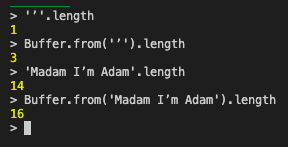The Content-Length story
July 08, 2021
TLDR; The fix is therefore to use Buffer.from(string).length to set Content-Length instead of string.length.
What’s Content-Length?
It’s an HTTP header both the client and the server use to denote the size of the request/response body.
Story time
- Was working with a POST API endpoint that expected some text in the request body.
- The code was already in place and we faced issues where some requests were failing and we couldn’t reproduce it in other environments. (Mistake: Didn’t use the exact same text to reproduce in other env)

After spending hours and days debugging this issue, we found out that the API was returning a JSON parse error.
The request body that looked something like this
{
"text": "Madam I’m Adam"
}
Simple json, JSON parse error? Whaat?
The culprit : Content-Length.
The call looked something like this
fetch(url, {
headers: {
'Content-Type': 'application/json',
'Content-Length`: requestBody.length
},
body: requestBody
})The Issue
When there’s a non ascii, multi-byte character, such as this apostrophe for example ’, which is different from the regular ', string.length can’t be used to calculate Content-Length.
While string.length gives the size of the string, it is only the character count. It’s not the actual size the string takes up in bytes/octets.
MDN says Content-Length is The length in decimal number of octets.
See the difference here. We can use Buffer.from(string).length to get the actual size of the string
So string.length gives a lower value than the actual size of the request body. API looks at the lower Content-Length chops off the last few bytes, what that means is the request might end up lookin like this
{
"text": "Madam I’m Adam"
Notice the missing }. This causes the JSON parse error.
The fix is therefore to use Buffer.from(string).length to set Content-Length.
FYI: GET with Request Body requires us to send Content-Length header explicitly, whereas for PUT & POST you can choose to not send it.
